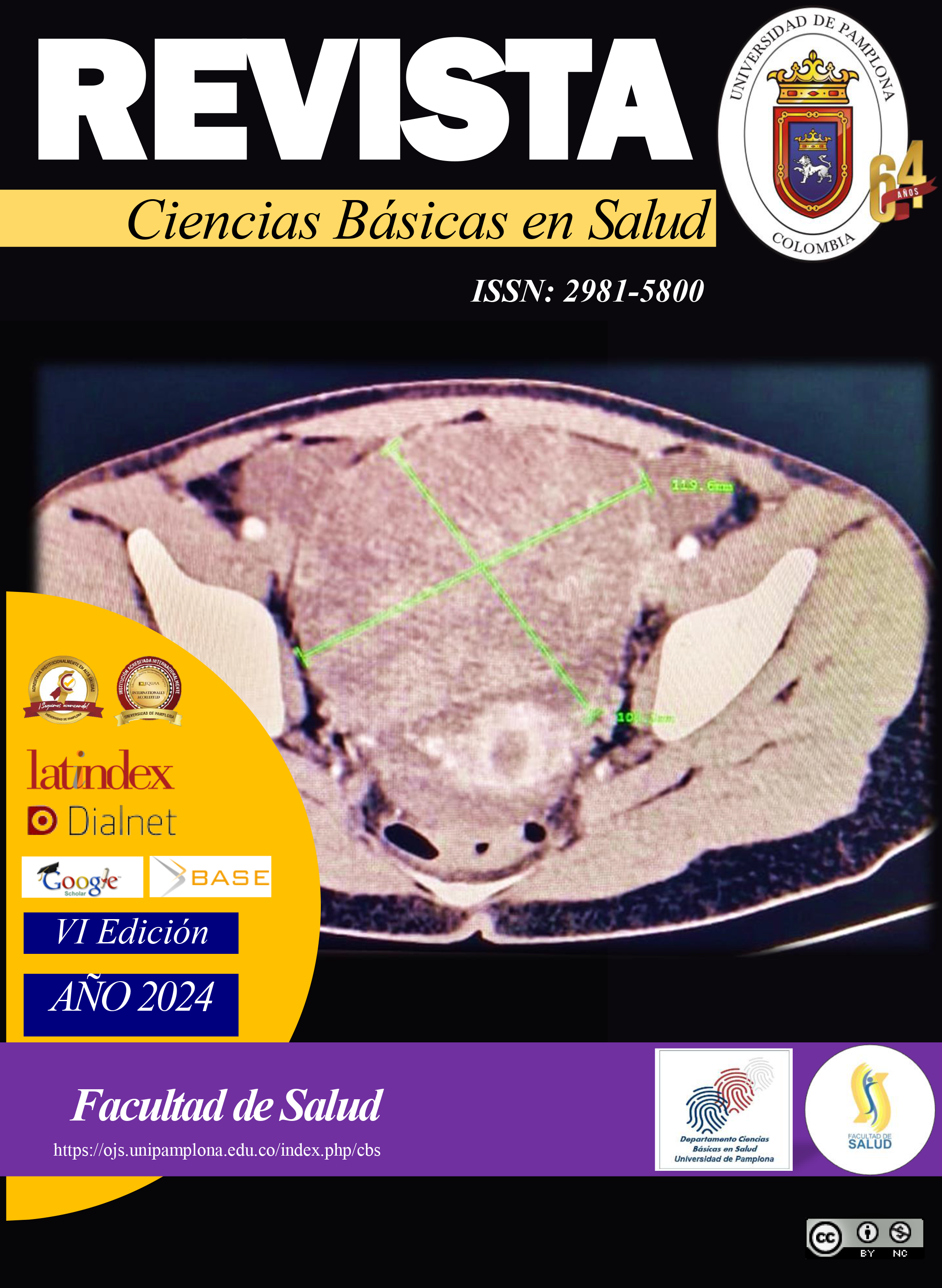Prevalencia y caracterización clínica de colestasis neonatal en un hospital de tercer nivel de atención en un período de 4 años
DOI:
https://doi.org/10.24054/cbs.v2i4.3286Palabras clave:
colestasis neonatal, bilirrubina directa, hepatobiliar, nutrición parenteralResumen
Introducción: La colestasis neonatal se define como la disminución del flujo y/o excreción biliar que conlleva a la acumulación de sustancias que normalmente son excretadas por la bilis hacia el intestino. Desde el punto de vista bioquímico, se caracteriza por un nivel de bilirrubina directa en sangre > 1 mg/dl (17 µmol/L). La incidencia oscila entre 1 de cada 2500 recién nacidos a término. Las enfermedades que causan colestasis incluyen un gran número de etiologías las cuales varían desde desórdenes genéticos hasta patologías infecciosas. Un diagnóstico oportuno y el inicio del tratamiento para causas tratables de colestasis son cruciales para limitar el daño hepático progresivo y prevenir las lesiones en otros órganos. Objetivo: Establecer la prevalencia y las características clínicas de la colestasis neonatal en un hospital universitario de tercer nivel de atención en Cúcuta, Colombia. Materiales y métodos: Estudio observacional, retrospectivo y descriptivo. Se realizo la revisión total de seiscientas un historias clínicas de las cuales se incluyó 42 historias clínicas para nuestro estudio. A las variables cuantitativas se les calculo media y desviación estándar y a las cualitativas frecuencia y porcentajes. El análisis estadístico se realizó con Epi Info™ Versión 7.2. Resultados: El número de nacidos vivos en los 4 años fue de 25447, alcanzando una proporción de 4 casos por cada 2500 nacidos vivos, predominio el género masculino en el 69 %. Entre las etiologías las infecciosas en un 59.5%, nutrición parenteral y sin etiología especifica representado el 21.4%, causas obstructivas en el 16.7% y metabólicas en el 2.4%.Conclusión: En nuestro estudio identificamos que la etiología infecciosa representó la principal causa de colestasis así mismo como la exposición a antibióticos y exposición a nutrición parenteral.
Descargas
Referencias
Fawaz R, Baumann U, Ekong U, Fischler B, Hadzic N, Mack CL, et al. Guideline for the Evaluation of Cholestatic Jaundice in Infants. J Pediatr Gastroenterol Nutr. 2017 Jan;64(1):154-68.
Harpavat S, Ramraj R, Finegold MJ, Brandt ML, Hertel PM, Fallon SC, et al. Newborn Direct or Conjugated Bilirubin Measurements as a Potential Screen for Biliary Atresia. J Pediatr Gastroenterol Nutr. 2016 Jun;62(6):799-803.
Lee WS. Pre-admission consultation and late referral in infants with neonatal cholestasis. J Paediatr Child Health. 2008 Jan 4;44(1-2):57-61.
Feldman AG, Sokol RJ. Neonatal Cholestasis: Updates on Diagnostics, Therapeutics, and Prevention. Neoreviews. 2021 Dec 1;22(12):e819-36.
Godoy M, López C, Álvarez Chavez F, Borges Pinto R, Botero Osorio V, Dolz Aguilar MV, et al. Colestasis neonatal: revisión narrativa del grupo de trabajo de la Sociedad Latinoamericana de Gastroenterología, Hepatología y Nutrición Pediátrica. Acta Gastroenterol Latinoam. 2022 Sep 29;52(3):344-54.
Satrom K, Gourley G. Cholestasis in Preterm Infants. Clin Perinatol. 2016 Jun;43(2):355-73.
Frederick J. Suchy. Neonatal Cholestasis. Pediatric Rev. 2004;25(11):388-96.
Feldman AG, Sokol RJ. Neonatal cholestasis: emerging molecular diagnostics and potential novel therapeutics. Nat Rev Gastroenterol Hepatol. 2019 Jun 22;16(6):346-60.
Balistreri WF, Bezerra JA. Whatever Happened to “Neonatal Hepatitis”? Clin Liver Dis. 2006 Feb;10(1):27-53.
Dick MC, Mowat AP. Hepatitis syndrome in infancy--an epidemiological survey with 10 years follow up. Arch Dis Child. 1985 Jun 1;60(6):512-6.
Gonzales E. Liver diseases related to MDR3 (ABCB4) gene deficiency. Frontiers in Bioscience. 2009; Volume (14):4242.
Liu L, Wang X, Lu Y, Zhu Q, Wang J. Association of variants of ABCB11 with transient neonatal cholestasis. Pediatrics International. 2013 Apr 16;55(2):138-44.
Goldschmidt ML, Mourya R, Connor J, Dexheimer P, Karns R, Miethke A, et al. Increased frequency of double and triple heterozygous gene variants in children with intrahepatic cholestasis. Hepatology Research. 2016 Apr 14;46(4):306-11.
Harpavat S, Garcia-Prats JA, Shneider BL. Newborn Bilirubin Screening for Biliary Atresia. New England Journal of Medicine. 2016 Aug 11;375(6):605-6.
Sundaram SS, Mack CL, Feldman AG, Sokol RJ. Biliary atresia: Indications and timing of liver transplantation and optimization of pretransplant care. Liver Transplantation. 2017 Jan 21;23(1):96-109.
Tufano M, Nicastro E, Giliberti P, Vegnente A, Raimondi F, Iorio R. Cholestasis in neonatal intensive care unit: incidence, aetiology, and management. Acta Paediatr. 2009 Nov 5;98(11):1756-61.
Mendoza JJ, De Vivero Camacho R, Muñoz Alvarez NA, Suarez Causado A, Moneriz Pretell C. Colestasis neonatal: reporte de 21 casos en un hospital infantil de Cartagena, Colombia. Rev Colomb Gastroenterol. 2015 Mar 30;30(1):92.
Jacquemin E, Lykavieris P, Chaoui N, Hadchouel M, Bernard O. Transient neonatal cholestasis: Origin and outcome. J Pediatr. 1998 Oct;133(4):563-7.
Potter CJ. Cholestasis in the Premature Infant. Clin Perinatol. 2020 Jun;47(2):341-54.
Beath SV, Davies P, Papadopoulou A, Khan AR, Buick RG, Corkery JJ, et al. Parenteral nutrition—Related cholestasis in postsurgical neonates: Multivariate analysis of rick factors. J Pediatr Surg. 1996 Apr;31(4):604-6.
Hermans D, Talbotec C, Lacaille F, Goulet O, Ricour C, Colomb V. Early Central Catheter Infections May Contribute to Hepatic Fibrosis in Children Receiving Long-term Parenteral Nutrition. J Pediatr Gastroenterol Nutr. 2007 Apr;44(4):459-63.
Hsieh MH, Pai W, Tseng HI, Yang SN, Lu CC, Chen HL. Parenteral Nutrition-associated Cholestasis in Premature Babies: Risk Factors and Predictors. Pediatr Neonatol. 2009 Oct;50(5):202-7.
Christensen RD, Henry E, Wiedmeier SE, Burnett J, Lambert DK. Identifying patients, on the first day of life, at high-risk of developing parenteral nutrition-associated liver disease. Journal of Perinatology. 2007 May 8;27(5):284-90.
Calkins KL, Havranek T, Kelley-Quon LI, Cerny L, Flores M, Grogan T, et al. Low-Dose Parenteral Soybean Oil for the Prevention of Parenteral Nutrition-Associated Liver Disease in Neonates with Gastrointestinal Disorders. Journal of Parenteral and Enteral Nutrition. 2017 Mar 29;41(3):404-11.
Madnawat H, Welu AL, Gilbert EJ, Taylor DB, Jain S, Manithody C, et al. Mechanisms of Parenteral Nutrition-Associated Liver and Gut Injury. Nutrition in Clinical Practice. 2020 Feb 23;35(1):63-71.
Descargas
Publicado
Número
Sección
Licencia
Derechos de autor 2024 Revista Ciencias Básicas en Salud

Esta obra está bajo una licencia internacional Creative Commons Atribución-NoComercial 4.0.







